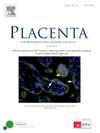细胞外基质诱导滋养细胞HtrA4表达:胎盘增生谱发病机制的意义
IF 3
2区 医学
Q2 DEVELOPMENTAL BIOLOGY
引用次数: 0
摘要
目的研究绒毛外滋养细胞中HtrA4的表达上调和蜕膜缺陷中HtrA1的表达下调是否强调了胎盘增生谱(PAS)发生的机制。方法选取因PAS产后出血或子宫张力不全行剖宫产子宫切除术的患者(n = 15)和对照组(n = 15);N = 10)进行免疫染色分析。观察细胞外基质(ECM)对滋养细胞HtrA4表达的影响,以及HtrA4在滋养细胞上皮间质转化、增殖、侵袭和HtrA1抑制中的作用。结果secm分子ⅰ型胶原、ⅳ型胶原、纤维连接蛋白、层粘连蛋白在蜕膜和肌层中高表达。用这些分子培养滋养细胞可诱导HtrA4的表达。HtrA4上调N-cadherin、vimentin、整合素β1、snail和matrix metalloproteinase-2的表达,下调occlenula -1的表达。HtrA4敲除抑制了这些作用。HtrA4敲除或重组HtrA1预处理均可抑制HtrA4诱导的滋养细胞侵袭。HtrA4促进滋养细胞增殖。在受PAS影响的绒毛粘附部位,许多具有强HtrA4表达的绒毛外滋养细胞侵入肌层。在不粘附部位和对照标本中观察到相对较少的胞外滋养细胞;这些滋养细胞表达弱或不表达HtrA4。HtrA1主要在蜕膜上表达。讨论ecm在蜕膜和肌层诱导滋养细胞HtrA4表达。个体HtrA1抑制htra4诱导的滋养细胞侵袭。在不抑制HtrA1的情况下,PAS患者的滋养细胞中HtrA4的表达和侵袭上调。HtrA4和HtrA1在母胎界面的相互作用可能参与了PAS的发病机制。本文章由计算机程序翻译,如有差异,请以英文原文为准。
Extracellular matrix induces trophoblast HtrA4 expression: Implications for the pathogenesis of placenta accreta spectrum
Objective
To study whether the upregulation of HtrA4 expression in extravillous trophoblasts and the downregulation of HtrA1 expression in defective deciduae underlined the mechanisms of placenta accreta spectrum (PAS) development.
Methods
Tissue samples from patients undergone cesarean hysterectomy because of postpartum hemorrhage due to PAS (n = 15) or uterine atony (control group; n = 10) were analyzed through immunostainings. The effect of extracellular matrix (ECM) on trophoblast HtrA4 expression, and HtrA4 in the alteration of trophoblast epithelial-to-mesenchymal transition, proliferation, invasion and HtrA1 inhibition were assessed.
Results
ECM molecule collagen I, collagen IV, fibronectin, or laminin were highly expressed in decidua and myometrium. Culturing trophoblasts with these molecules induced HtrA4 expression. HtrA4 upregulated the expression of N-cadherin, vimentin, integrin β1, snail, and matrix metalloproteinase-2 but downregulated that of zonula occludens-1. HtrA4 knockdown inhibited these effects. HtrA4 knockdown or pretreatment with recombinant HtrA1 inhibited HtrA4-induced trophoblast invasion. HtrA4 promoted trophoblast proliferation. Numerous extravillous trophoblasts exhibiting strong HtrA4 expression invaded the myometrium at the villous adherence sites affected by PAS. Relatively few extravillous trophoblasts were observed at the nonadherence sites and in the control specimens; these trophoblasts exhibited weak or no HtrA4 expression. HtrA1 was primarily expressed over the decidua.
Discussion
ECM in decidua and myometrium induced trophoblast HtrA4 expression. Decidual HtrA1 inhibited HtrA4-induced trophoblast invasion. Without the inhibition of HtrA1, HtrA4 expression and invasion was upregulated in the trophoblasts of patients with PAS. The reciprocal effects of HtrA4 and HtrA1 at the maternal-fetal interface may be involved in the pathogenesis of PAS.
求助全文
通过发布文献求助,成功后即可免费获取论文全文。
去求助
来源期刊

Placenta
医学-发育生物学
CiteScore
6.30
自引率
10.50%
发文量
391
审稿时长
78 days
期刊介绍:
Placenta publishes high-quality original articles and invited topical reviews on all aspects of human and animal placentation, and the interactions between the mother, the placenta and fetal development. Topics covered include evolution, development, genetics and epigenetics, stem cells, metabolism, transport, immunology, pathology, pharmacology, cell and molecular biology, and developmental programming. The Editors welcome studies on implantation and the endometrium, comparative placentation, the uterine and umbilical circulations, the relationship between fetal and placental development, clinical aspects of altered placental development or function, the placental membranes, the influence of paternal factors on placental development or function, and the assessment of biomarkers of placental disorders.
 求助内容:
求助内容: 应助结果提醒方式:
应助结果提醒方式:


